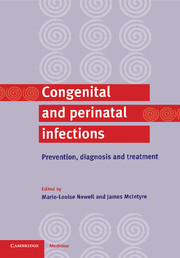Book contents
- Frontmatter
- Contents
- List of contributors
- Preface
- Part I General issues
- Part II Specific infections
- 5 Rubella infection in pregnancy
- 6 Perinatal Group B streptococcal infections
- 7 Mother-to-child transmission of cytomegalovirus
- 8 Varicella
- 9 Herpes simplex
- 10 Vertical transmission of hepatitis viruses
- 11 Papillomavirus infections as a perinatal problem: diagnosis, prevention and management
- 12 HIV-1 infection
- 13 Syphilis: prevention, diagnosis and management during pregnancy and infancy
- 14 The other sexually transmitted diseases
- 15 Toxoplasmosis
- 16 Neonatal sepsis
- Index
11 - Papillomavirus infections as a perinatal problem: diagnosis, prevention and management
Published online by Cambridge University Press: 06 July 2010
- Frontmatter
- Contents
- List of contributors
- Preface
- Part I General issues
- Part II Specific infections
- 5 Rubella infection in pregnancy
- 6 Perinatal Group B streptococcal infections
- 7 Mother-to-child transmission of cytomegalovirus
- 8 Varicella
- 9 Herpes simplex
- 10 Vertical transmission of hepatitis viruses
- 11 Papillomavirus infections as a perinatal problem: diagnosis, prevention and management
- 12 HIV-1 infection
- 13 Syphilis: prevention, diagnosis and management during pregnancy and infancy
- 14 The other sexually transmitted diseases
- 15 Toxoplasmosis
- 16 Neonatal sepsis
- Index
Summary
Papillomavirus infections as a perinatal problem
Human papillomaviruses (HPVs) are DNA viruses; more than 100 HPV types have been identified to date. HPV types are categorized into low- and high risk, depending on the sort of lesions they induce, such as benign hyperplastic lesions, cancer precursors or invasive cancers. Different HPV types are capable of infecting skin and a variety of mucous membranes at different anatomical sites, including the genital tract, gastrointestinal and respiratory tracts (Syrjänen & Syrjänen, 2000). In addition, HPV lesions have been found in the urinary tract and in the eye (Chan et al., 1997; McDonnell et al., 1987).
There is a strong causal relationship between HPV and cervical cancer (zur Hausen, 1994; Schiffman et al., 1993; Millikan, 1994; Bosch et al., 1995). Indeed, certain high-risk types (HPV 16 and 18) are the single most important risk factors of cervical cancer (IARC, 1995), and are likely to also be implicated in other human malignancies. It has been estimated that up to. 10–15% of all human malignancies might be linked with HPV infections (Syrjänen & Syrjänen, 2000). In the present chapter, issues relating to perinatal acquisition of HPV infections are discussed. Other manifestations (e.g. laryngeal papillomas) of HPV are discussed only as far as pertinent to their transmission by the vertical route.
Prevalence and Incidence
Genital HPV infection is considered to be a primarily sexually transmitted disease (STD) and most studies have concentrated on HPV infections of the genital tract. However, despite the ubiquitousness of HPV infections with an estimated life-time risk of genital infection of 80% (Syrjänen et al., 1990), few people have clinically detectable genital HPV lesions at any point of time.
- Type
- Chapter
- Information
- Congenital and Perinatal InfectionsPrevention, Diagnosis and Treatment, pp. 205 - 231Publisher: Cambridge University PressPrint publication year: 2000

